
Alfréd Rényi Institute of Mathematics, and
University of Szeged, Hungary
Anti-balancing vector sums
Vector sum problems have been studied for over a hundred years. The basic balancing question is as follows: given a finite set of unit vectors $u_1, \ldots, u_n \in S^{d-1}$, can we assign signs $\pm 1$ to them so that the signed sum becomes small? Now, we set off to study the dual problem: we are to seek appropriate signs so that the signed sum of the unit vectors has large norm. We study several variants of the question, including signed subset sums. Based on combinatorial, analytic and geometric tools, we give asymptotic bounds as well as sharp estimates in specific cases. This is a joint work with Bernardo González Merino.
[top]

Tel-Aviv University, Israel
Some new perspectives on duality
We discuss some new results, directions and conjectures regarding dualities on families of sets.
[top]

TU Wien, Austria
Weighted Floating Body of Polytopes
In this talk I will present a joint work together with C. Schütt and E. M. Werner where we establish asymptotic results for the weighted floating body of $d$-dimensional convex polytope. The weighted floating body is a generalization of the classical floating body which arises by replacing the Euclidean volume with a measure that has a positive and continuous density function.
In our results we establish an interesting connection between the weighted volume of the weighted floating body and the number of complete flags of the polytope. This flag number is an important combinatorial invariant and is the same as the number of simplices obtained in the barycentric subdivision. An application of our main results shows that the same asymptotic behavior for the volume of the floating body of a convex polytope can be observed also in spherical and hyperbolic geometry.
[top]
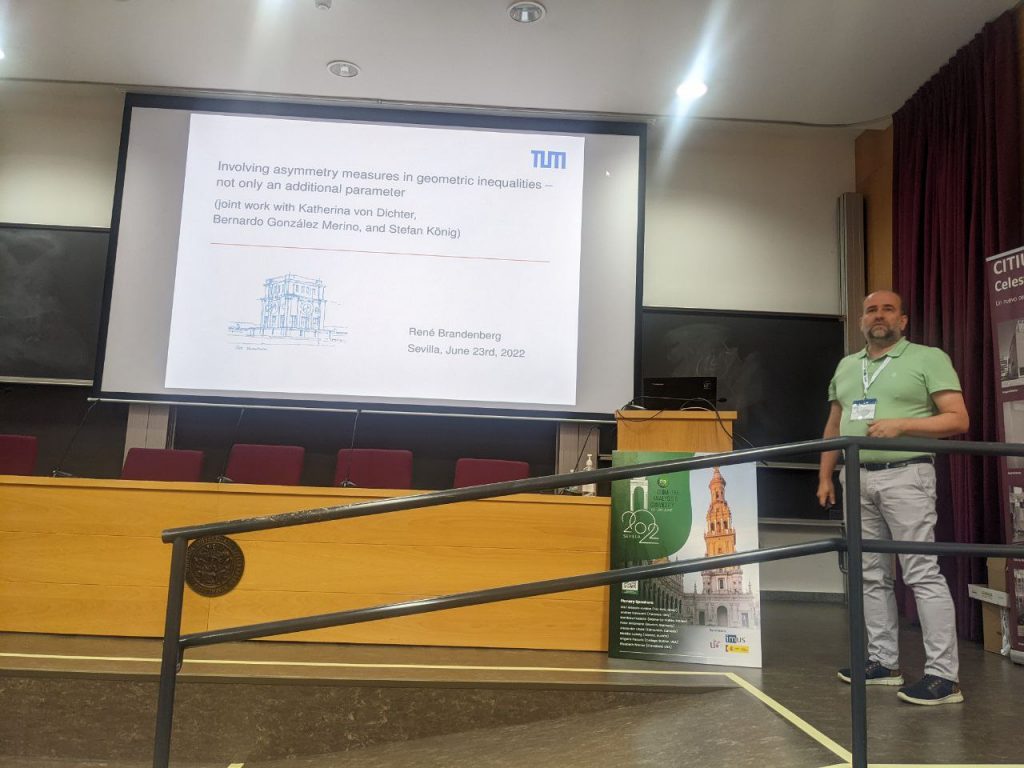
Technical University of Munich, Germany
Involving asymmetry measures in geometric inequalities – not only an additional parameter
In recent years, we have succeeded in incorporating asymmetry measures into quite a number of geometric inequalities. In doing so, we have tightened some inequalities, and brought together symmetric and general ends in others. For pairs of well-known inequalities, we were able to show that they are two sides of the same coin, and we succeeded in inverting inequalities where an inversion would not have been possible without additional parameters. It should also be noted that the asymmetry measures used can usually be computed well algorithmically, at least for polyhedra. This talk will give an overview of the results obtained.
[top]

Universidad de Sevilla, Spain
Optimal divisions of a convex body
For a given convex body $C\subset\mathbb{R}^d$, and a division of $C$ into $n$ convex subsets $C_1,\ldots,C_n$, we can consider $\max{F(C_1),…, F(C_n)}$ (or respectively, $\min{F(C_1),…, F(C_n)}$), where $F$ represents one of these classical geometric functionals: the diameter, the width or the inradius.
In this work we study the divisions of $C$ which minimize (respectively, maximize) that previous value. In particular, we will focus on the existence, uniqueness and balancing behaviour of optimal divisions, bounds for the corresponding optimal values, as well as algorithms leading to these optimal divisions. This is part of a joint work with Isabel Fernández and Alberto Márquez (Universidad de Sevilla).
[top]

Technische Universität Berlin, Germany
Finite sphere packings in low and high dimensions
The Sausage Conjecture of L. Fejes Tóth (1975) states that for all dimensions $d \geq 5$, the densest packing of any finite number of spheres in $\mathbb{R}^{d}$ occurs if and only if the sphere centers are all placed as closely as possible on one line, i.e., a ”sausage´´. We discuss the progress made in the literature, including the result of Betke and Henk (1998) that the Sausage Conjecture is true for all $d\geq 42$. Our work builds upon the methods of Betke and Henk to improve the lower bound to $d \geq 36$ with the aid of interval arithmetic for certain complicated portions.
The Sausage Catastrophe of J. Wills (1983) is the observation that in $d = 3$ and $d = 4$, the densest packing of $n$ spheres is a sausage for small values of $n$ and jumps to a full-dimensional packing for large $n$ without passing through any intermediate dimensions. Let $n_{d}$ be the smallest value of $n$ for which the densest packing of $n$ spheres in $\mathbb{R}^{d}$ is full-dimensional. We discuss some upper and lower bounds for $n_{3}$ and $n_{4}$, including $n_{3} \leq 56$ by Wills (1985) and $n_{4} < 375.769$ by Gandini and Zucco (1992). We present some improvements to the upper bound for $n_{4}$ via extending the work of Gandini and Zucco, and also mention some potential future research directions for both the conjecture and the catastrophe.
[top]

Università degli Studi di Firenze, Italy
Some recent results concerning valuations on Lipschitz functions
The first part of the talk will be devoted to an overview on the theory of valuations defined on spaces of functions. We will then focus on valuations on the space of Lipschitz functions defined on the unit sphere of the $n$-dimensional Euclidean space. No general classification result is known for such valuations, even under the assumption of rotation invariance. After describing some partial results in this direction, we will turn to the smaller class of those valuations which are additionally invariant under the sum of linear functions. For them, we show a homogeneous decomposition result of McMullen type. We will also see that, in fact, no valuations of degree of homogeneity higher than three may exist, and we will present a classification result for the remaining degrees of homogeneity, both in the rotation invariant case, and in the general case. The original results that I will present were obtained in collaboration with: J. Knoerr, D. Pagnini, P. Tradacete and I. Villanueva.
[top]

Tel Aviv University, Israel
A quasianalytic-type property of functions in geometric tomography
The two ubiquitous functions in geometric tomography associated to a centrally-symmetric n-dimensional convex body are the volume-of-section and volume-of-projection, by/to subspaces of dimension k. Those functions lie in the range of the Radon and cosine transforms, respectively. We will show that when $k$ lies between 2 and $n-2$, those ranges exhibit a quasianalytic-type property, allowing the unique determination of a function from its values on a small subset. This readily leads to sharpenings of theorems of Funk and Alexandrov, as well as Klain’s injectivity theorem from valuation theory.
[top]

Université Gustave Eiffel, France
On the volume of Minkowski sum of convex sets
I shall show a nice conjecture of T. Courtade on the volume of the Minkowski sum of convex bodies and establish it in dimension 2. Then, I shall prove a weaker versions of it in dimension 3, some other special cases in dimension $n$ and connect it to inequalities between volume of projections of convex bodies. The talk is based on a joint work with Mokshay Madiman, Mathieu Meyer and Artem Zvavitch.
[top]

TU München, Germany
Diagrams, clustering, and coresets, and their application to the representation of polycrystals
We study geometric diagrams and their relation to constrained clustering with a view towards representing and analyzing polycrystalline materials and their dynamics. We introduce various techniques for converting grain maps into geometric diagrams. In particular, weight-constrained anisotropic clustering allows to compute diagram respresentations from data on the volume, center and moments of the grains which are available through tomographic measurements. Also we develop new coreset techniques, interesting in their own right, which are utilized to significantly accelerate the computations. This effect is demonstrated on 3D real-world data sets. The talk is based on recent joint work with A. Alpers, M. Fiedler, F. Klemm.
[top]

Friedrich Schiller University Jena, Germany
Let $W$ be an irreducible representation of $\mathrm{SL}(n)$ of finite dimension. We ask whether there exists a non trivial continuous and translation invariant Minkowski valuation $\mathcal{K}(\mathbb{R}^n) \to \mathcal{K}(W)$ which is $\mathrm{SL}(n)$ equivariant. Here $\mathcal{K}(\bullet)$ denotes the space of convex bodies in the corresponding vector space. For $W = \mathbb{R}^n$ and $W = (\mathbb{R}^n)^*$ the answer is positive and by a result of Monika Ludwig all such valuations are multiples of the difference body and the projection body respectively. We show that $W = \mathbb{R}$ is the only additional case where such a valuation exists. New examples arise if we omit translation invariance. This is a joint work with Thomas Wannerer.
[top]

TU Vienna, Austria
Algebraic structures on valuations on convex functions
At the heart of modern integral geometry is the algebraic theory of valuations initiated by Alesker, in particular the Alesker product and Bernig-Fu convolution, which define partial product structures on the space of translation invariant valuations on convex bodies. Recently, many results from the theory of valuations on convex bodies have been extended to the class of dually epi-translation invariant valuations on convex functions and I will talk about an extension of these two product structures to this functional setting. For the Alesker product, this extension relies on a description of a dense subspace of the space of all such valuations in terms of mixed Hessian valuations, a functional analog of mixed volumes. This characterization can be seen as a version of McMullen’s conjecture for dually epi-translation invariant valuations on convex functions.
[top]

Jagiellonian University in Cracow, Poland
A uniform lower bound on the norms of hyperplane projections of spherical polytopes
For a given centrally symmetric spherical polytope in the $n$-dimensional space, satisfying some quite general conditions, we provide a uniform lower bound on the norms of all hyperplane projections in terms of the determinant function of vertices and facets. We apply this result to the case of random spherical polytope with a large number of vertices to obtain a uniform lower bound on the norms of all hyperplane projections, which is true with a high probability. This lower bound is polynomial with the respect to the number of vertices of the random polytope.
[top]

Kent State University, USA
General measure extensions of projection bodies
The inequalities of Petty and Zhang are affine isoperimetric-type inequalities providing sharp bounds for $\textrm{vol}^{n-1}_{n}(K)\textrm{vol}_n(\Pi^\circ K),$ where $\Pi K$ is a projection body of a convex body $K$. In this paper, we present a number of generalizations of Zhang’s inequality to the setting of arbitrary measures. In addition, we introduce extensions of the projection body operator $\Pi$ to the setting of arbitrary measures and functions, while providing associated inequalities for this operator; in particular, Zhang-type inequalities. Throughout, we apply shown results to standard Gaussian measure.
[top]

Budapest University of Technology, Hungary
Isoperimetric problems for zonotopes
Shephard (Canad. J. Math. 26, 302-321, 1974) proved a decomposition theorem for zonotopes yielding a simple formula for the volume of the zonotope. In this talk we present a generalization of this theorem yielding similar formulas for the intrinsic volumes of the zonotope. Based on this, we investigate isoperimetric type problems for zonotopes generated by a given number of segments. In particular, we solve such problems for parallelotopes and rhombic dodecahedra, and give asymptotic estimates for the solutions of these problems for zonotopes generated by sufficiently many segments. In addition, we present applications of our results to polarization problems on the sphere and a vector-valued Maclaurin-inequality conjectured by Brazitikos and McIntyre in 2021. Joint work with A. Joós.
[top]

University of Alberta, Canada
On the singularity of random $\pm 1$ and $0/1$ matrices
We discuss recent progress on singularity of random matrices with i.i.d. Bernoulli entries. The talk is partially based on a joint work with K. Tikhomirov.
[top]

Universidad de Murcia, Spain
Discretization of geometric inequalities via the lattice point enumerator
The obtaining of discrete analogues of classical inequalities has seen a significant increase in recent times in the field of Convex Geometry. Among some of the most common measures utilized for this purpose are the cardinality and the lattice point enumerator, i.e., the cardinality of a set intersected with a lattice, often the integer one. Apart from having applications in other fields, like number theory, they sometimes provide alternative ways to further progress in the original setting, due to the fact that some of these inequalities imply their corresponding continuous analogues.
In this talk we will discuss recent progress with regards to the discretization of several well-known inequalities in the field, including the Brunn-Minkowski inequality, the isoperimetric inequality, and the Rogers-Shephard inequality, via the lattice point enumerator. These inequalities are often sharp and imply their original analogues.}{This talk is based on joint work with D. Alonso-Gutiérrez, M. A. Hernández Cifre, D. Iglesias, and J. Yepes Nicolás.
[top]

Technische Universität Wien, Austria
A functional $\operatorname{\rm Z}$ defined on a space of real-valued functions ${\mathcal F}$ is called a valuation if \begin{equation}\label{valuation} \operatorname{\rm Z}(f\vee g)+\operatorname{\rm Z}(f\wedge g)=\operatorname{\rm Z}(f) +\operatorname{\rm Z} (g) \end{equation} for all $f,g\in {\mathcal F}$ such that $f,g, f\vee g, f\wedge g\in {\mathcal F}$. Here $f\vee g$ is the pointwise maximum of $f$ and $g$, while $f\wedge g$ is their pointwise minimum. The important, classical notion of valuations on convex bodies is a special case of the rather recent notion of valuations on function spaces.
We present a complete classification of all continuous, epi-translation and rotation invariant valuations on the space of super-coercive convex functions on ${\mathbb R}^n$. This result corresponds to Hadwiger’s celebrated theorem on the classification of continuous, translation and rotation invariant valuations on the space of convex bodies. The valuations obtained in our theorem are functional versions of the classical intrinsic volumes. Representations and important properties will be described. Based on joint work with Andrea Colesanti and Fabian Mussnig.
[top]

Universidad de Murcia, Spain
On extensions of Grünbaum’s inequality
A classical result by Grünbaum provides a sharp lower bound for the ratio
$$
\textrm{vol}(K^{-})/\textrm{vol}(K)
$$ of a convex body $K\subset\mathbb{R}^n$ that depends only on the dimension $n$ (here $K^{-}$ denotes the intersection of $K$ with a halfspace bounded by a hyperplane passing through its centroid). In this work, on the one hand, we will discuss various recent results in the spirit of finding a generalization of Grünbaum’s inequality, in both a geometric and a functional setting. On the other hand, we will show further generalizations of this result to the case of cuts (by hyperplanes) through other particular points.}{This is part of joint work with David Alonso-Gutiérrez, Javier Martínez Goñi and Jesús Yepes Nicolás.
[top]

UNAM at Queretaro, Mexico
Complex ellipsoids and complex symmetry
The solution of the complex isometric Banach conjecture: ”if any two n-dimensional subspaces of a complex Banach space V are isometric, then V is a Hilbert space´´ realizes heavily in a characterization of the complex ellipsoid.
An ellipsoid is the image of a ball under an affine transformation, if this affine transformation is over the complex numbers, we refer to it as a complex ellipsoid. Characterizations of real ellipsoids have received much attention over the years, however, characterizations of complex ellipsoids have been scarcely studied. The purpose of this talk is the study of complex ellipsoids which is naturally related to the study of complex symmetry. So, characterizing and understanding complex symmetry is vital to characterizing complex ellipsoids. Our main contribution is an unexpected characterization of complex ellipsoids which has no analogue over the real numbers.
It is interesting to note the use of various types of topological techniques in the proofs of most of our results. Joint work with Jorge Arocha and Javier Bracho.
[top]

Loránd Eötvös University, and
CoGe Research Group, Budapest, Hungary
Löwner’s problem for log-concave functions
The class of logarithmically concave functions is a natural extension of the class of convex sets in Euclidean $d$-space. Several notions and results on convex sets have been extended to this wider class. We study how the problem of the smallest volume affine image of a given convex body $L$ that contains another given convex body $K$ can be phrased and solved for functions. Joint work with Grigory Ivanov and Igor Tsiutsiurupa.
[top]
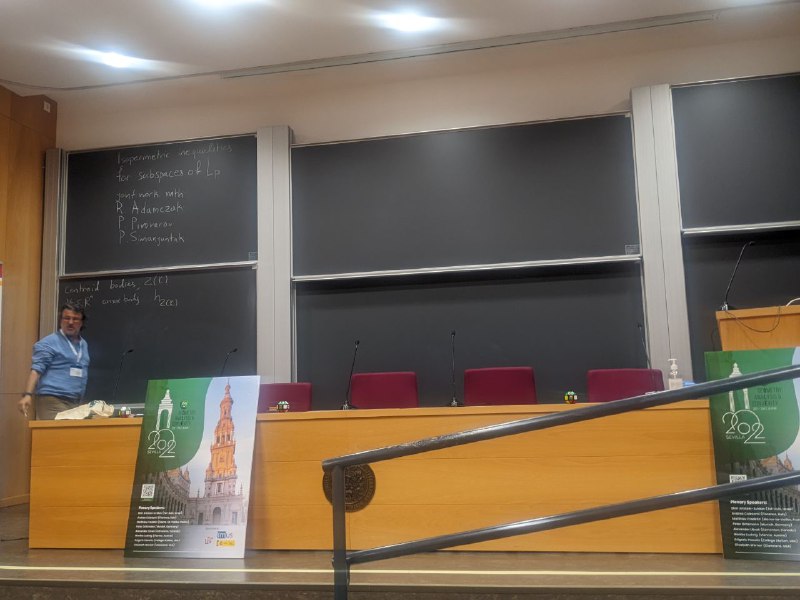
Texas A&M University, USA
Isoperimetric inequalities in $L_p$ spaces when $p<1$
We establish a family of isoperimetric inequalities for polar $L_p$-centroid bodies that interpolate between the classical inequalities of Lutwak-Zhang for polar-centroid bodies and Busemann inequality for intersection bodies. The approach depends on new empirical versions of these inequalities. Based on joint work in progress with R. Adamczak, P. Pivovarov and P. Simanjuntak.
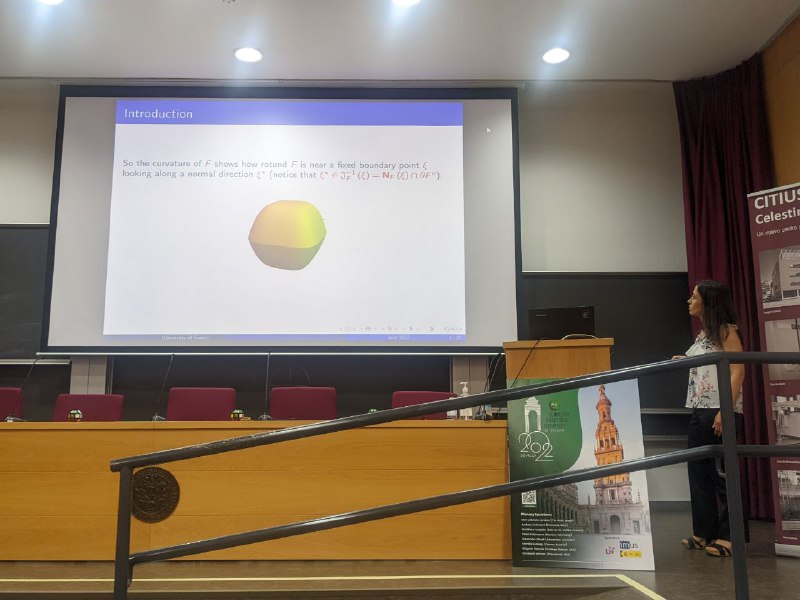
CIMA&Department of Mathematics, University of Évora, Portugal
Directional curvatures of convex bodies in $\mathbb{R}^{n}$
Take a point $\xi$ on the boundary of a convex body $F$ in $\mathbb{R}^{n}$, near which the boundary is given by an implicit equation. We present an easy formula to compute the curvature of $F$ at $\xi \ $in the direction of any its tangent vector. For this we consider the intersection curve between the boundary of $F$ and a suitable plane, without using the plane equations or the curve expression. But if we used them we would see that the formula we obtained is equivalent to the existing ones. We also show that when the directional curvature of $F$ is positive, then there is the directional derivative of the Minkowski functional of the polar set of $F$, and we propose a formula to calculate it.
[top]

AGH University of Science and Technology, Faculty of Applied Mathematics, Kraków, Poland
Ryll-Wojtaszczyk homogeneous polynomials on strictly convex circular domains in ${\mathbb C}^n$
The aim of this talk is to present some applications of the Ryll-Wojtaszczyk homogeneous polynomials on strictly convex circular domains in ${\mathbb C}^n$. They were originally constructed in the unit ball by Ryll and Wojtaszczyk (Ryll J., Wojtaszczyk P., On homogeneous polynomials on a complex ball, Trans. Amer. Math. Soc. 276 (1983), p. 107-116) and found many applications, e.g. in the construction of the inner function in the unit ball (Aleksandrov A. B., Inner functions on compact spaces, Functional Anal. Appl. 18 (1984) 87–98). Then it turned out that similar homogeneous polynomials existed also in strictly convex circular domains in ${\mathbb C}^n$ (Kot P., Homogeneous polynomials on strictly convex domains, Proc. Amer. Math. Soc. 135 (2007), p. 3895-3903).
In this talk we will show how Ryll-Wojtaszczyk homogeneous polynomials can be applied in the investigation of the so-called Radon inversion problem for holomorphic functions on circular strictly convex domain $\Omega \subset {\mathbb C}^n$ (Pierzchała P., Kot P., Radon inversion problem for holomorphic functions on circular, strictly convex domains, Complex Anal. Oper. Theory 15, 80 (2021), p. 1-31), i.e. given $p>0$ and $H$ – a strictly positive continuous function on $\partial\Omega$ find a function $f$ holomorphic in $\Omega$ such that
$$
\int_0^1 \big|f(zt) \big|^p dt = H(z), \quad \textrm{where}~~ z \in \partial\Omega.
$$
[top]
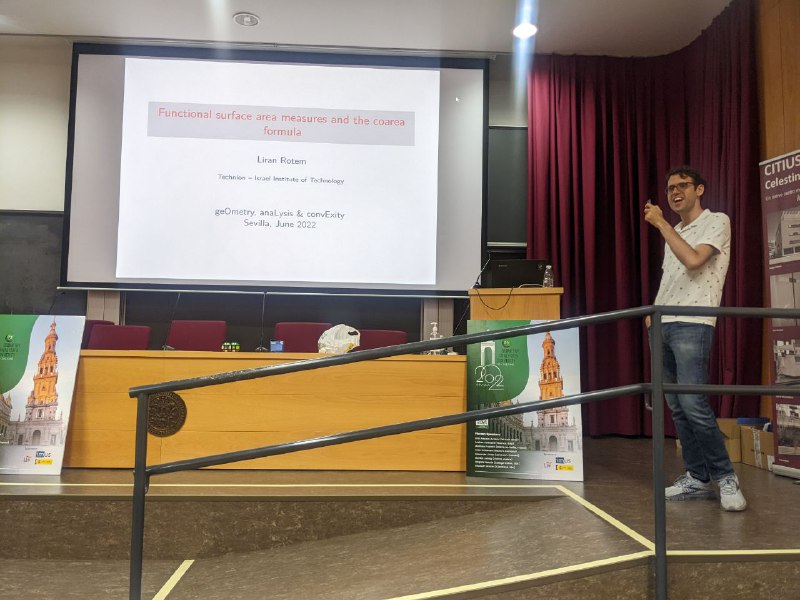
Technion – Israel Institute of Technology, Israel
Functional surface area measures and the co-area formula
The surface area measure of a convex body is one of the fundamental constructions in convexity. An extension of this construction to log-concave functions was studied by Colesanti and Fragalà, by Cordero-Erausquin and Klartag, and by myself. In this talk I will describe the previous results on the topic and present for the first time a variation formula for the integral of a log-concave function that holds in complete generality, with no regularity assumptions. As we will see such a formula is intimately related to the co-area formula, and in particular to anisotropic versions of the co-area formula that received very little attention in the literature. As a corollary of our result we will prove that the surface area measures (note the plural) of a log-concave function $f$ determines $f$ uniquely, again with no regularity assumptions.
[top]

Kent State University, USA
Ulam’s problem 19 from the Scottish Book and related problems
Ulam’s Problem 19 from the Scottish Book asks is a solid of uniform density which will float in water in every position a sphere? Assuming that the density of water is $1$, one can show that there exists a strictly convex body of revolution $K\subset {\mathbb R^3}$ of uniform density $\frac{1}{2}$, which is not a Euclidean ball, yet floats in equilibrium in every orientation. We will discuss this and related problems suggested by Croft, Falconer and Guy.
[top]

Universitat Autònoma de Barcelona, Spain
Rotational bounds for homeomorphisms with integrable distortion and Hölder continuous inverse
In this talk I will explain a recent work, in collaboration with Albert Clop and Lauri Hitruhin, where we have obtained sharp spiraling bounds for homeomorphisms with $L_p$-integrable distortion having Hölder continuous inverse. Our result certainly improves the bounds obtained by Hitruhin for homeomorphisms with integrable distortion without a priori assumption of Hölder continuous inverse. As an application, we estimate the spiraling rate of Euler flows for small times.
[top]

Université Paris Diderot, France
A new necessary condition for satisfying sharp Bezout inequalities
In 2018, Saroglou, Soprunov and Zvavitch introduced a set of inequalities between mixed volumes, involving the simplex, inherited from Bezout inequalities (from algebraic geometry). As implied by Diskant inequality, the simplex can be replaced by any convex body in these inequalities, up to multiplying by n. It is known the simplex is the only minimizer among polytopes, and conjecturally this characterization should hold among all convex bodies. Several necessary conditions for being a minimizer have been derived, excluding bodies (weakly) decomposable bodies, bodies with infinitely many facets, or bodies with at least one smooth point on their boundary. In this talk, I will discuss another excluding condition, involving isoperimetric ratios, reminiscent of Ball’s reverse isoperimetric inequality.
[top]
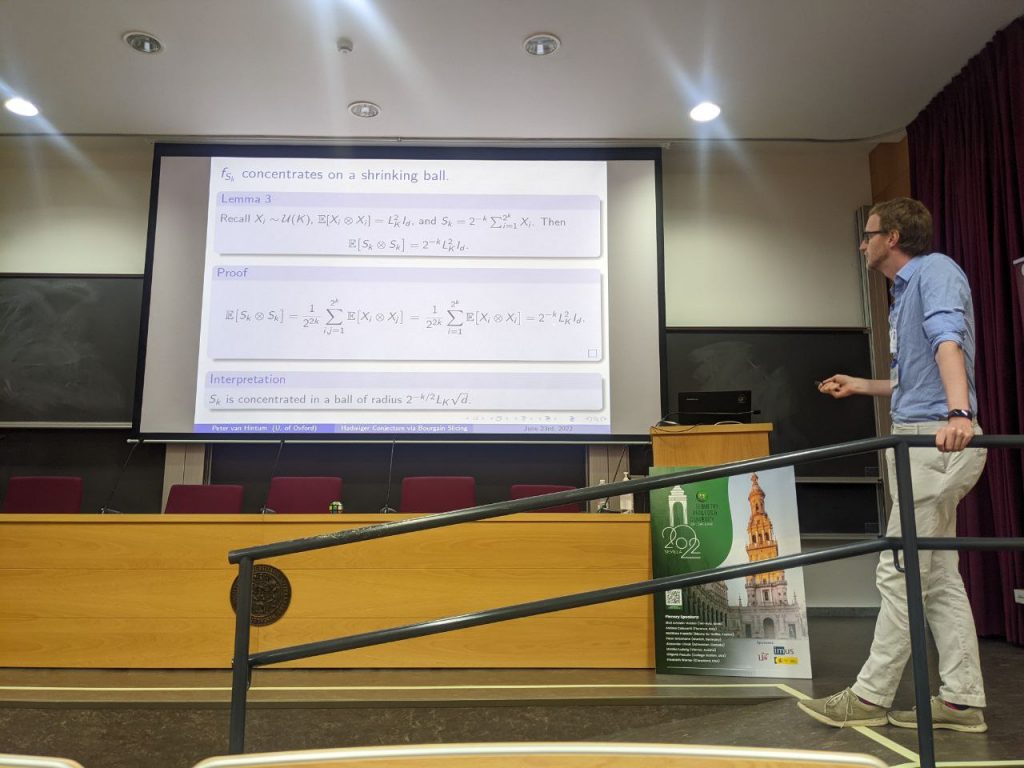
New College, Oxford, United Kingdom
Towards the Hadwiger Conjecture via Bourgain Slicing
In 1957, Hadwiger conjectured that every convex body in $\mathbb{R}^d$ can be covered by $2^d$ translates of its interior. For over 60 years, the best known bound was of the form $O(4^d\sqrt{d}\log(d))$, but this was recently improved by a factor of $e^{\Omega(\sqrt{d})}$ by Huang, Slomka, Tkocz and Vritsiou. In this talk, we take another step towards the Hadwiger conjecture by deducing an almost-exponential improvement from the recent breakthrough work of Chen, Klartag and Lehec on Bourgain’s slicing problem. More precisely, we prove that, for any convex body $K\subset\mathbb{R}^d$,
$$
\exp \left(-\ \frac{d}{(\log d)^{O(1)}} \right)4^d
$$ translates of $\text{int}(K)$ suffice to cover K. Moreover, a positive answer to Bourgain’s slicing problem would imply an exponential improvement on the bound for Hadwiger’s conjecture. This talk is based on joint work with Marcelo Campos, Robert Morris, and Marius Tiba.
[top]

University of Szeged, Hungary
Monohedral tilings of a smooth convex disc
In this talk we give a complete description about normal monohedral tilings of a convex disc with smooth boundary where we have at most three topological discs as tiles. This result is a far-reaching generalization of earlier results of Kurusa, Lángi and Vígh. Some further partial results are proved for non-normal tilings.}{This is a joint work with Kinga Nagy.
[top]

Universidad de Murcia, Spain
Rogers-Shephard type inequalities for the lattice point enumerator
In the late 50s, Rogers and Shephard provided different inequalities for some bodies associated to a convex body $K$, such as the so-called difference body $K-K:=K+(-K)$. Among others, they showed that \[\mathrm{vol}(K-K)\leq\binom{2n}{n}\mathrm{vol}(K)\] and \[\mathrm{vol}_{n-k}(P{H^{\perp}}K) \mathrm{vol}_{k}(K\cap H) \leq\binom{n}{k}\mathrm{vol}(K),\] where $\mathrm{vol}(\cdot)$ is the $n$-dimensional Lebesgue measure and $P{H^{\perp}}(\cdot)$ is the orthogonal projection onto the orthogonal complement of the $k$-dimensional vector subspace $H$.
In this talk we will discuss various Rogers-Shephard type inequalities for the lattice point enumerator $\mathrm{G}_n(\cdot):=|\cdot\cap\mathbb{Z}^n|$ on $\mathbb{R}^n$. In particular, we will present discrete analogues for this functional of the above classical inequalities, showing furthermore that these new discrete versions for $\mathrm{G}_n(\cdot)$ imply the corresponding results involving the Lebesgue measure. This is about joint work with David Alonso-Gutiérrez and Eduardo Lucas.
[top]

Case Western Reserve University, USA
Spherical convex hull of random points on a wedge
Consider two half-spaces $H_1^+$ and $H_2^+$ in $\mathbb{R}^{d+1}$ whose bounding hyperplanes $H_1$ and $H_2$ are orthogonal and pass through the origin. The intersection $\mathbb{S}_{2,+}^d:=\mathbb{S}^d\cap H_1^+\cap H_2^+$ is a spherical convex subset of the $d$-dimensional unit sphere $\mathbb{S}^d$ and is called a spherical wedge.
Choose $n$ independent random points uniformly at random on $\mathbb{S}_{2,+}^d$ and consider the expected facet number of the spherical convex hull of these points. It is shown that, up to terms of lower order, this expectation grows like a constant multiple of $\log n$. The result is compared to the corresponding behavior of classical Euclidean random polytopes and of spherical random polytopes on a half-sphere. Based on joint work with Florian Besau, Anna Gusakova, Matthias Reitzner, Carsten Schuett and Christoph Thaele.
[top]

